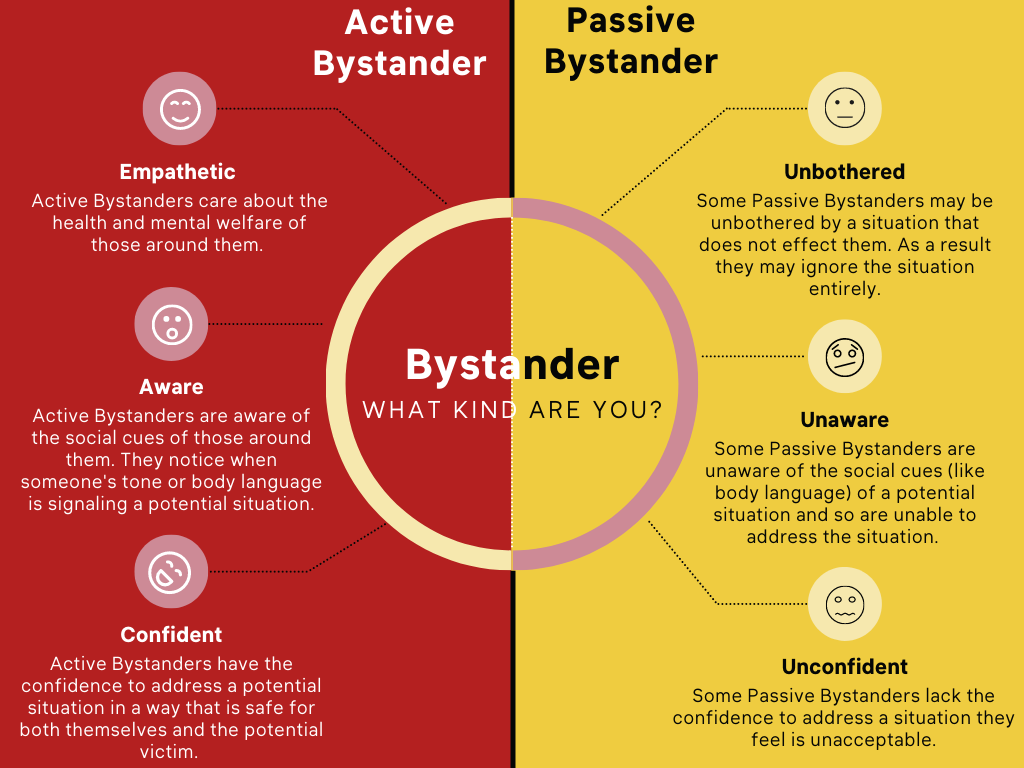Become an Active Bystander

Being an Active Bystander:
An active bystander is someone who chooses to take action when they witness inappropriate behavior. Being an active bystander in the workplace means taking appropriate steps (directly or indirectly) to put a stop to potential sexual harassment.
Being an Active Bystander at Work May Look Like:
1. Finding an excuse to interrupt a situation.
Example: You see two coworkers speaking. You can tell the male coworker is physically too close to the female coworker. The female is physically trying create distance but the male continues to follow. Being an Active Bystander, you casually walk up to them, apologize for interrupting, state you need the female’s help with a private matter. Note: If you are not comfortable doing this, another step you can take is immediatly reporting the incident to a supervisor who can take the necessary steps to address the situation.
2. Being Supportive.
Example: You witness or overhear a coworker being verbally harassed or demeaned. Being an Active Bystander, you offer the coworker your support letting them know you will testify as a witness to the harassment if they choose to report it.
3. Reporting to a Supervisor or HR Rep.
Example: You witnessed a fellow coworker being sexually harassed frequently. You have not had the confidence to place yourself in a situation in which you interrupt the harassment or extend a supportive attitude to the victim. Being an Active Bystander, you keep a record of the incidents that you have witnessed and submit your records to the HR department.
Being an Active Bystander vs. Being a Passive Bystander:
Passive Bystanders are:
1. Unbothered:
Example: Some Passive Bystanders may be unbothered by a situation that does not effect them. As a result they may ignore the situation entirely.
2. Unaware:
Example: Some Passive Bystanders are unaware of the social cues (like body language) of a potential situation and so are unable to address the situation.
3. Unconfident:
Example: Some Passive Bystanders lack the confidence to address a situation they feel is unacceptable.
Active Bystanders are:
1. Empathetic:
Example: Active Bystanders care about the health and mental welfare of those around them.
2. Aware:
Example: Active Bystanders are aware of the social cues of those around them. They notice when someone’s tone or body language is signaling a potential situation.
3. Confident:
Example: Active Bystanders have the confidence to address a potential situation in a way that is safe for both themselves and the potential victim.
Warning Signs of Harassment:
As discussed above, an Active Bystander must be aware of the situations around them in order to help. So, what are the warning signs of harassment that you should be aware of?
The signs of a Perpetrator:
1. Lacking physical boundaries.
Example: Perhaps this is a person who stands too close while talking to coworkers. Or perhaps this is someone who likes to physically place their hands on their coworkers (clapping shoulders, patting backs, touching hands, hugging).
2. Telling inappropriate Jokes.
Example: This person may like to tell jokes that are inappropriate in the workplace (sexual or otherwise).
3. Commenting on physical appearance.
Example: Whether positive or negative, perhaps this person makes frequent comments on their coworkers’ clothes, physical size, make-up, or hair.
4. Requesting to meet outside of work.
Example: Perhaps this person frequently requests coworkers to get together outside of work. This is not inherently a bad thing. However, if they continue to make requests after being repeatedly turned down, this may be a warning sign.
The signs of a Victim:
1. Feeling anxious.
Example: Perhaps you’ve noticed this person frequently looking over their shoulder or avoiding being alone.
2. Avoiding social situations.
Example: Perhaps this person has suddenly stop coming to work events, requesting virtual meetings over physical ones, or has lacked their usual work banter.
3. Concentration issues.
Example: Perhaps this person has been having trouble concentrating on their work tasks or is clearly distracted during meetings.
4. Quickly irritated.
Example: Perhaps this person has started getting irritated easily with a specific coworker or perhaps this irritation is not directed at a specific coworker but is all encompassing.
If you have noticed any of these warning signs:
This does not inherently mean that sexual harassment is taking place. However, being aware of these potential signs may help you be better prepared for situations where you may need to be an Active Bystander in stopping harassment in the workplace.
